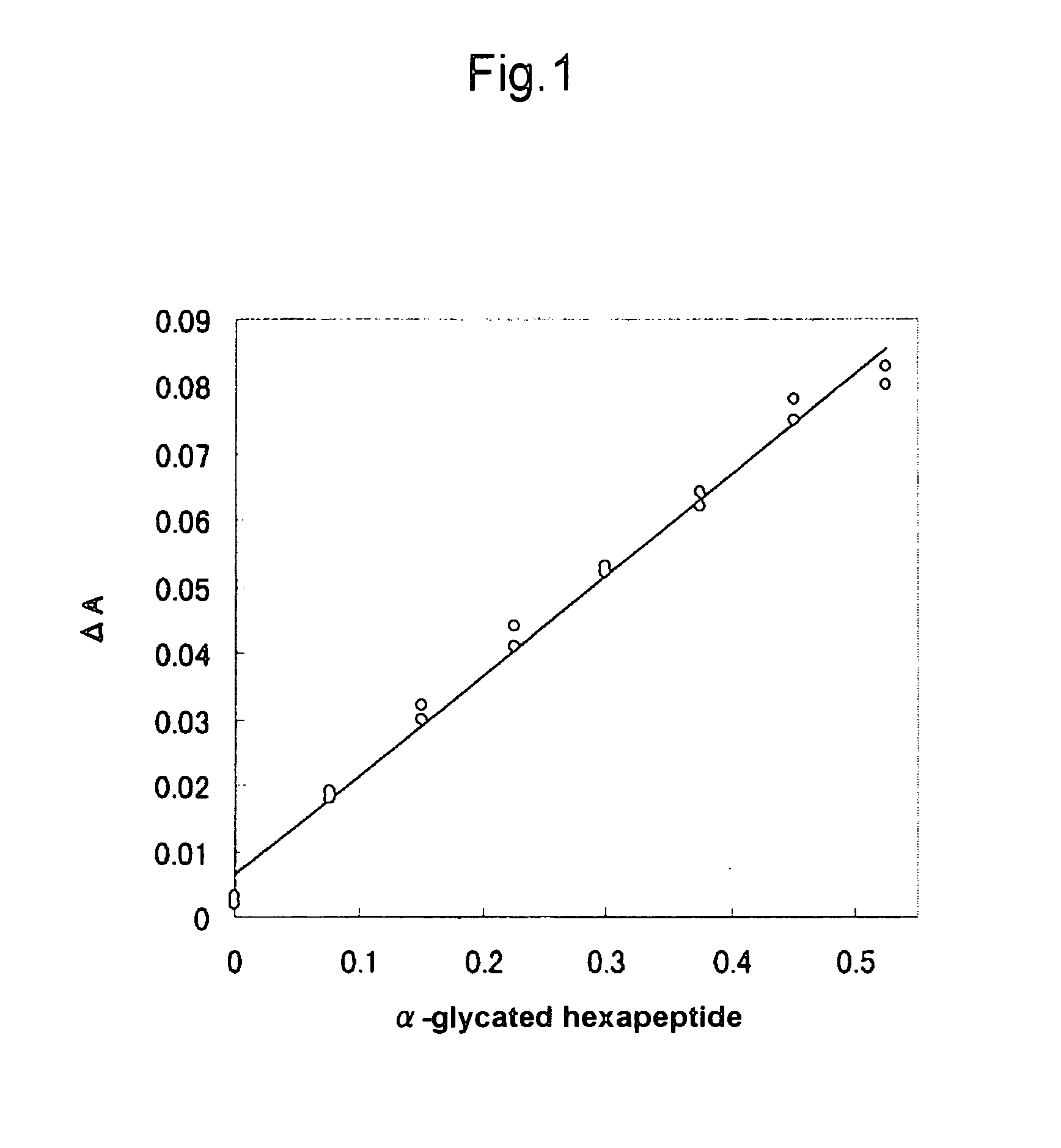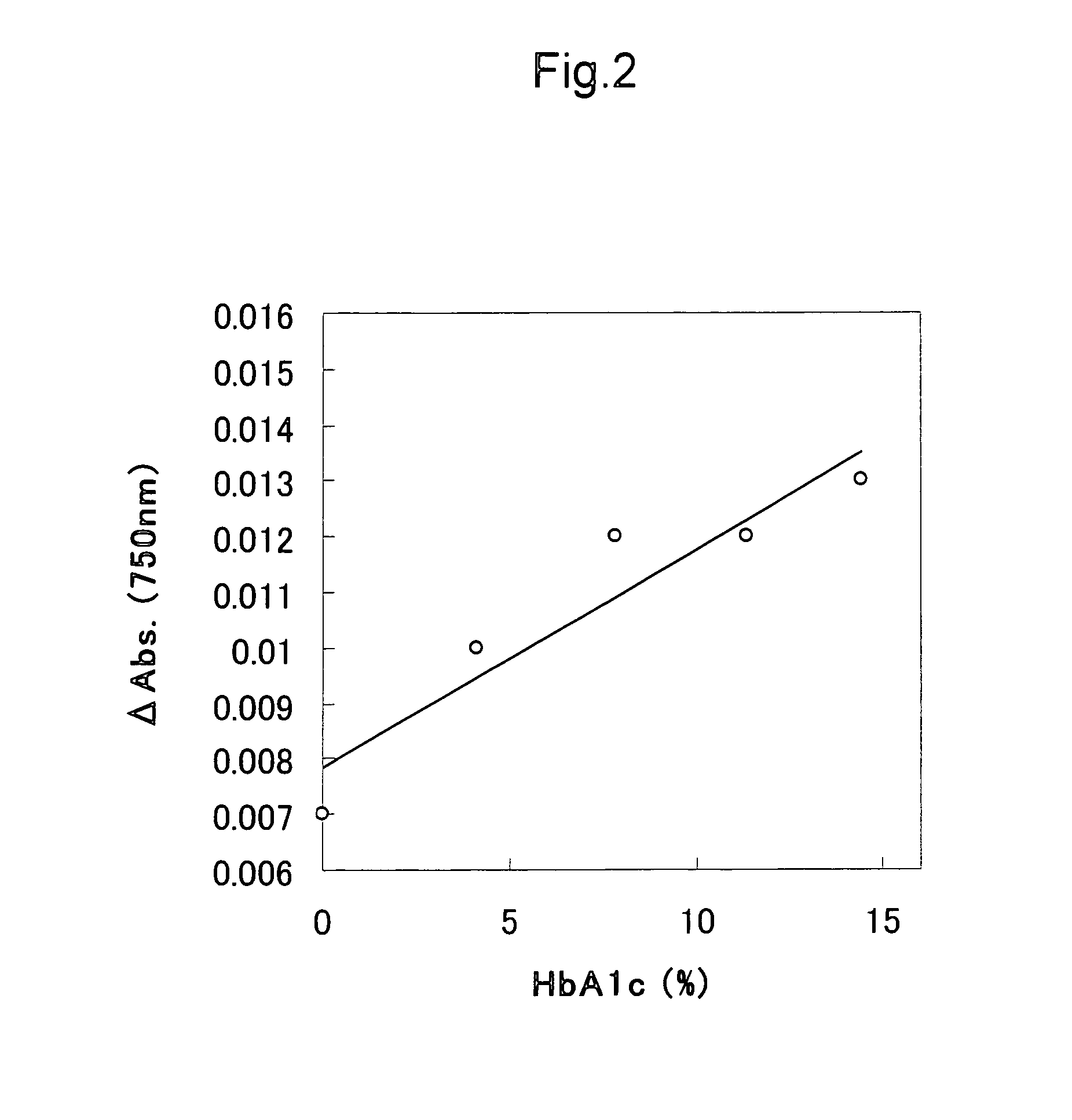Process for producing alpha-glycosylated dipeptide and method of assaying alpha-glycosylated dipeptide
a technology of alpha-glycosylated dipeptide and assay method, which is applied in the field of process for producing alphaglycosylated dipeptide and method of assaying alphaglycosylated dipeptide, can solve the problems of special apparatus and complicated procedures, inefficient economic efficiency, etc., and achieve the effect of high precision
- Summary
- Abstract
- Description
- Claims
- Application Information
AI Technical Summary
Benefits of technology
Problems solved by technology
Method used
Image
Examples
example 1
Liberation of Glycated Dipeptide from Glycated Hexapeptide
[0061] To screen for proteases capable of efficiently excising α-glycated dipeptide, proteases listed in Table 1 were caused to act on α-glycated hexapeptide (fructosyl Val-His-Leu-Thr-Pro-Glu; produced by PEPTIDE INSTITUTE, INC.). The amounts of the thus generated products were determined using fructosyl peptide oxidases or a fructosyl amino acid oxidase.
[0062] 1.8 mM α-glycated hexapeptide: 12 μl [0063] 20 mg / ml Protease solution (the solution was prepared at as high a concentration as possible when this concentration was unable to be achieved, or the same concentration was used when protease was in a liquid state): 8 μl [0064] 100 mM Potassium phosphate buffer pH 8.0 (pH was appropriately changed according to the optimum protease pH): 4 μl
[0065] The above ingredients were mixed well and then allowed to react at 37° C. for 2 hours. The resultant was subjected to heat treatment at 90° C. for 3 minutes and then centrifuged...
example 2
Activity of Protease to Excise Glycated Dipeptide with Short Reaction Time
[0077] To screen for proteases capable of efficiently excising α-glycated dipeptide within shorter reaction times, experiments similar to those in Example 1 were carried out without changing the various conditions thereof The reaction time period for protease was shortened to 5 minutes from 2 hours, however. The amounts of α-glycated dipeptide and α-glycated amino acid were determined after reaction. The results are represented by the following equation (similar to that in Example 1)
ΔA=(A1−A0)−(A1 blank−A0 blank)
[0078] The results are also summarized in Table 2 (units; mAbs).
TABLE 2ProteasenameOriginFPOX-CFPOX-EFAOXFLODAO proteaseKIKKOMANAspergillus241920PeptidaseKIKKOMAN0100MolsinKIKKOMAN1001Protease PAmano1199101SumizymeShin Nihon1249510MPChemicalDispaseRocheBacillus987101Proteinase NFluka1058400Protease SAmano1199000Proteinase KRocheTritirachium262022PapainRochePapaya896400
[0079] As a result of compariso...
example 3
Confirmation of Liberated Glycated Dipeptide by HPLC
[0080] The above α-glycated hexapeptide was dissolved in water, so as to prepare 5 mM solutions. 0.01 mL of a protease solution (papain (produced by Roche), ficin (produced by Sigma-Aldrich Corporation), or dispase (produced by Roche)) and 0.09 mL of a buffer (0.1 M) were added to and mixed with 0.1 mL of each of the above solutions. Thus, protease treatment was carried out. The above mixtures were allowed to react at 37° C. for 60 minutes. Subsequently, each treated solution was appropriately condensed and diluted and then subjected to HPLC determination. For HPLC (reverse phase high performance liquid chromatography), CAPCEL-PAK C-18 (produced by Shiseido Co., Ltd.) was used. The resultants were eluted with gradient using 0.1% TFA (trifluoroacetic acid) / water-0.1% TFA / 30% acetonitrile as an eluant. As a standard substance, an α-glycated dipeptide (fructosyl Val-His) was used. As a result, it was confirmed that α-glycated dipepti...
PUM
| Property | Measurement | Unit |
|---|---|---|
| concentration | aaaaa | aaaaa |
| concentration | aaaaa | aaaaa |
| pH | aaaaa | aaaaa |
Abstract
Description
Claims
Application Information
 Login to View More
Login to View More - R&D
- Intellectual Property
- Life Sciences
- Materials
- Tech Scout
- Unparalleled Data Quality
- Higher Quality Content
- 60% Fewer Hallucinations
Browse by: Latest US Patents, China's latest patents, Technical Efficacy Thesaurus, Application Domain, Technology Topic, Popular Technical Reports.
© 2025 PatSnap. All rights reserved.Legal|Privacy policy|Modern Slavery Act Transparency Statement|Sitemap|About US| Contact US: help@patsnap.com


